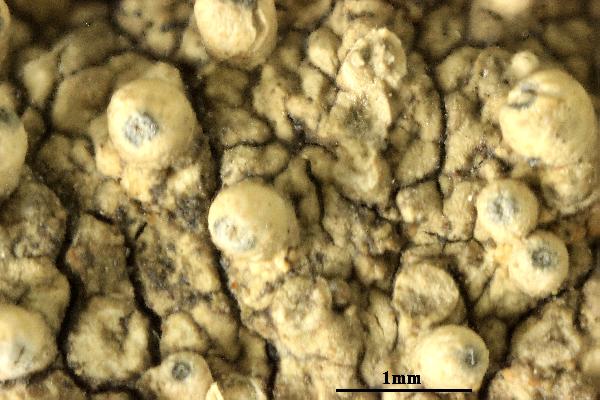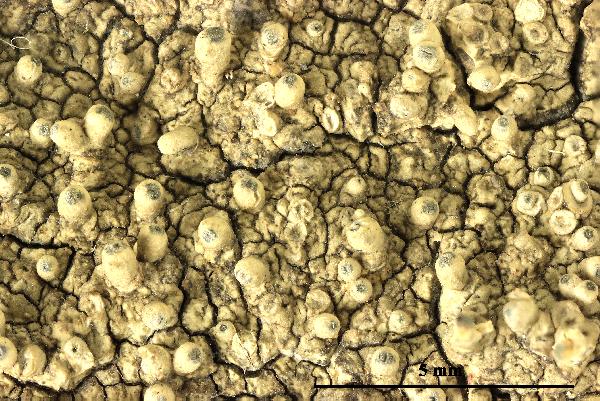Lepra schaereri (Hafellner) Hafellner
in Hafellner & Türk, Stapfia, 104: 172, 2016. Basionym: Pertusaria schaereri Hafellner - Stapfia, 76: 155, 2001.
Synonyms: Spiloma isidioides Schaer.
Description: Thallus crustose, episubstratic, white to pale grey, rather thick, continuous to rimose-areolate, with scattered, isidia-like, short-cylindrical, sometimes apically widened, usually simple (rarely with a few branches) up to 0.4(-0.6) mm thick and to 0.6(-1.2) mm tall papillae. Apothecia not known. Photobiont chlorococcoid. Spot tests: cortex and medulla K-, C-, KC- or KC+ very pale yellow (medulla only), P-, UV-; medulla I+ pinkish brown, without a bitter taste. Chemistry: unidentified fatty acids.
Growth form: Crustose
Substrata: rocks
Photobiont: green algae other than Trentepohlia
Reproductive strategy: mainly asexual, by isidia, or isidia-like structures (e.g. schizidia)
Commonnes-rarity: (info)
Alpine belt: rare
Subalpine belt: extremely rare
Montane belt: absent
Dry submediterranean belt: absent
Humid submediterranean belt: absent
Padanian area: absent
pH of the substrata:
1 2 3 4 5
Solar irradiation:
1 2 3 4 5
Aridity:
1 2 3 4 5
Eutrophication:
1 2 3 4 5
Poleotolerance:
0 1 2 3
Altitudinal distribution:
1 2 3 4 5 6
Rarity
absent
extremely rare
very rare
rare
rather rare
rather common
common
very common
extremely common
Loading data...
Occurrence data
Predictive map

P.L. Nimis; Owner: Department of Life Sciences, University of Trieste
Herbarium: TSB (25159)
2002/05/14
Growth form: Crustose
Substrata: rocks
Photobiont: green algae other than Trentepohlia
Reproductive strategy: mainly asexual, by isidia, or isidia-like structures (e.g. schizidia)
Commonnes-rarity: (info)
Alpine belt: rare
Subalpine belt: extremely rare
Montane belt: absent
Dry submediterranean belt: absent
Humid submediterranean belt: absent
Padanian area: absent
pH of the substrata:
| 1 | 2 | 3 | 4 | 5 |
Solar irradiation:
| 1 | 2 | 3 | 4 | 5 |
Aridity:
| 1 | 2 | 3 | 4 | 5 |
Eutrophication:
| 1 | 2 | 3 | 4 | 5 |
Poleotolerance:
| 0 | 1 | 2 | 3 |
Altitudinal distribution:
| 1 | 2 | 3 | 4 | 5 | 6 |
Rarity
absent
extremely rare
very rare
rare
rather rare
rather common
common
very common
extremely common
Loading data...
Occurrence data
Predictive map



















